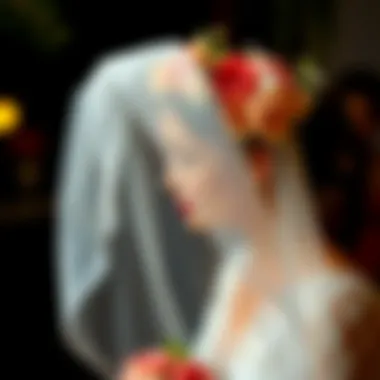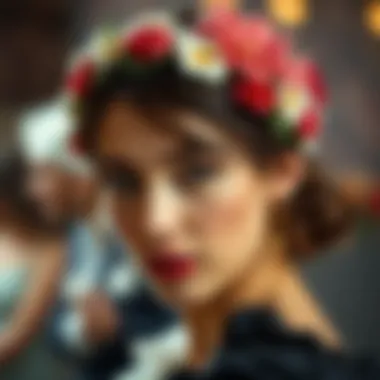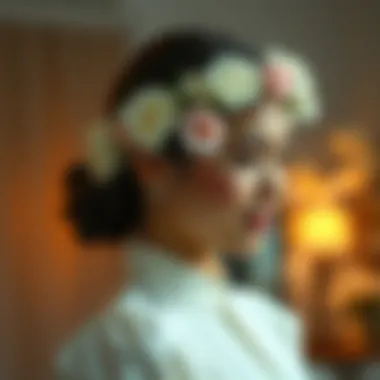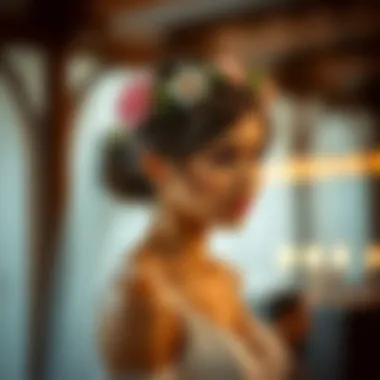The Wedding Floral Headband: Trends and Styles Revealed


Intro
As wedding trends ebb and flow, one accessory that has remained a steadfast favorite is the floral headband. This enchanting piece of adornment carries a rich tapestry of history and cultural significance, transcending mere aesthetics to encapsulate emotions, traditions, and the beauty of nature itself. For today’s couples, the floral headband is more than just a cute addition; it holds the power to convey personal style while seamlessly tying into the wedding's overall theme.
When it comes to choosing a floral headband, the possibilities are vast. With an array of flowers and materials to select from, each headband tells a unique story, reflecting the couple's journey and the ambiance of the day. Exploring the evolution of this accessory, its styling options, and its care requires a careful examination of several factors – from fabric knowledge to style tips.
The charm of a floral headband lies in its versatility. Be it a bohemian garden wedding or an elegant ballroom event, the right headband can transform any hairstyle and even elevate an outfit. As we look into these aspects, it becomes clear that the floral headband is not merely an accessory; it's a personal statement woven from love and artistry.
This exploration will dive into the realms of fabric choices, styling strategies, and cultural influences, providing a comprehensive guide for those looking to make this meaningful piece a part of their special day.
Fabric Knowledge
Types of Fabrics
When discussing floral headbands, one cannot overlook the various fabrics that lend themselves to this beautiful accessory. Here are some common materials you might encounter:
- Cotton – Soft and breathable, cotton is a popular choice for rustic or beach weddings due to its natural feel.
- Silk – Often associated with elegance, silk features a luxurious sheen that complements formal occasions.
- Organza – This lightweight fabric can add volume and a whimsical touch, making it an excellent choice for more ethereal designs.
- Linen – Perfect for summer weddings, linen offers a crisp texture that can easily match outdoor themes.
- Chiffon – With its soft drape, chiffon headbands can create a flowing look, ideal for romantic styles.
Choosing the right fabric often depends on the overall theme and season of the wedding. It's important to consider both the aesthetic and functional qualities of each material.
How to Care for Different Fabrics
Maintaining the beauty of your floral headband is as crucial as the selection process. Different fabrics require varied care:
- Cotton: Machine washable on gentle cycles but should be laid flat to dry, avoiding drying machines which can shrink them.
- Silk: Best treated with delicate hand washing; avoid wringing, and air dry away from direct sunlight to prevent fading.
- Organza and Chiffon: Quick spot cleaning for stains will do the trick; these fabrics can be delicate, so careful handling is necessary.
- Linen: Regular washing will help maintain its texture, but ironing is often needed to keep it looking crisp.
By selecting suitable fabrics and understanding their care, you can keep your floral headband looking fresh and vibrant, ready to shine on the big day.
Style Tips
Outfit Pairing Strategies
The key to achieving a harmonious bridal look is pairing the floral headband with the right ensemble. Here are some strategies to consider:
- Match Flowers with Bouquets: Creating a cohesive look is crucial. Ensure the flowers on the headband mirror the bouquets or décor of your wedding.
- Complimentary Colors: Pay attention to the color palette of your wedding. Choose headbands that fit seamlessly into the overall aesthetic.
- Balance Elegance and Whimsy: A formal wedding dress can be beautifully complemented by a delicately adorned floral headband, whereas a more casual outfit might pair well with a wildflower-inspired piece.
Seasonal Fashion Trends
Understanding seasonal fashion trends can significantly enhance wedding planning. Different seasons lend themselves to different floral arrangements:
- Spring: Think peonies, cherry blossoms, and pastel colors, perfect for fresh, blooming looks.
- Summer: Sunflowers and daisies are ideal for vibrant, sunny aesthetics. Bright colors work best here.
- Autumn: Deep, rich hues like burgundy and gold can be highlighted with flowers such as marigolds and dahlias.
- Winter: Evergreens and white flowers blend beautifully with winter themes, bringing a touch of magic to the season.
Each season brings unique opportunities to express style through a floral headband, connecting the wedding setting with nature's rhythm.
In synthesizing the elements discussed, it’s evident that floral headbands hold a significant place in wedding attire. Their adaptability across styles, themes, and seasons makes them a versatile choice for any bride looking to make an impact. By thoughtfully selecting materials, considering outfit pairings, and paying attention to seasonal trends, couples can ensure their floral headbands are not only beautiful but meaningful as well. Sources for further reading can be found on Wikipedia or Britannica.
Prolusion to Wedding Floral Headbands
Wedding floral headbands represent more than just a trend; they encapsulate a rich tapestry of history, emotion, and celebration. As brides navigate their special day, the choice of floral adornments becomes a significant part of their narrative, wrapping them in a visual story. These headbands not only enhance a wedding's aesthetics but also allow brides to express their personal style and cultural heritage.
One striking aspect of floral headbands is their approachability. Whether a bride is planning a grand ceremony in a lavish venue or a quaint gathering in a rustic setting, a floral headband seamlessly fits into any theme. The versatility of styles caters to a wide range of wedding themes, which in turn is a game changer for brides-to-be. The lightweight feel and the stunning visuals of these pieces can elevate the bridal look from ordinary to something celestial.
When considering the importance of floral headbands, one cannot overlook their cultural significance. Throughout history, florals have symbolized a myriad of emotions from love to fidelity. It isn't just about aesthetics; it's about carrying these sentiments on one's head on a day filled with promise and commitment. Brides often find that pairing these headbands with flowers that hold personal meaning adds layers of intimacy, making the accessory even more special.
There are practical elements to the floral headband as well. They often serve as a bridge between modern trends and timeless styles. For example, while minimalism reigns supreme in some wedding designs, the boldness of floral accents stands firm against the test of trends, making them a staple accessory for years to come.
"In every culture, flowers symbolize joy, love, and happiness, making them the perfect accessory for weddings."
On a more functional level, floral headbands often come with considerations that need attention. From choosing the right material—be it fresh blooms or artificial arrangements—to ensuring the overall comfort, these are practical steps that smoothen a bride's experience. After all, beauty should not come at the cost of comfort.
In summary, the introduction of wedding floral headbands is a celebration of individuality, culture, and modern-day elegance. It invites brides to step into the spotlight with grace, enhancing their beauty with layers of meaning and reflection. As we delve deeper into this exquisite accessory, we’ll explore its historical context, modern interpretations, and practical pointers for selection and maintenance.
Historical Context of Floral Headbands
The allure of floral headbands has roots that stretch back to ancient landscapes, painting a vivid picture of how flowers have been entwined with cultural expressions, ceremonies, and individual identity. Understanding the historical context of these accessories not only enhances our appreciation for them today but also deepens the connection to the traditions that have inspired modern designs. Floral headbands have transitioned from mere decorative items to symbols rich with meaning, and exploring their history can illuminate the motivations behind their contemporary revival.
Originating Traditions
The use of floral adornments can be traced back to various civilizations. In ancient Greece, for instance, fresh flowers were worn as crowns by victors in athletic competitions and by brides during marital ceremonies. A common flower used at weddings was the myrtle, symbolizing love and fidelity. Similarly, the Romans took this trend further, integrating various flowers into their cultural festivities. Roman brides often wore a blend of flowers to invoke blessings from deities; the Romans believed flora could channel auspicious energies during significant life events.
Beyond Europe, the tradition has extended to cultures across the globe. In Hindu weddings, floral garlands known as "jaimalas" are used not only to beautify but also to signify the bond between the couple. In Hawaiian culture, the flower crown, or "lei," is worn as a representation of the spirit of Aloha, creating an ambiance of welcoming and love.
The materials and flowers differ from one culture to another, yet the connection remains the same: flowers serve as carriers of meaning, a powerful metaphor for life’s beauty and fragility.
Symbolism Through the Ages
Throughout history, floral headbands have represented myriad themes and meanings. They serve an essential role not just in aesthetic appeal but in communicating deeper societal values and beliefs. Flowers have always been tied to various traditions, embodying ideals ranging from purity, fertility, and love to deeper connections with nature and the cycles of life.
For example, the lily has long been associated with purity and innocence, making it a popular choice for brides. Conversely, roses symbolize love and passion, their colors altering the meaning — red for deep love, while white suggests a pure bond. Each flower comes with its own rich tapestry of significance, often steeped in folklore and age-old customs.
As time progressed, the meanings of these floral accessories also evolved. In the Victorian era, the language of flowers, or "floriography," became all the rage, allowing individuals to communicate feelings and sentiments without uttering a single word. A headband adorned with specific blooms could send a message about love, friendship, or even grief.
"In the intricate dance of history, floral headbands reveal the intimate relationship between nature and humanity, showcasing how blossoms can narrate stories upholding cultural legacies."
Understanding the layered meanings behind these floral decorations allows modern audiences to connect with their wedding day choices on a level beyond mere decoration. This historical context emphasizes the importance of selecting flowers that resonate personally, enhancing both the aesthetic and emotional dimensions of one’s special day.
Observe how floral headbands have transitioned from the past to modernity, each representing a fundamental combination of beauty, sentiment, and significance. As couples design their ceremonies, they find comfort in the rich history that informs their choices, evoking traditions while shaping new narratives.
Modern Interpretations of Floral Headbands
The emergence of floral headbands as a fashionable accessory for weddings cannot be overstated. As we delve into modern interpretations, it is evident that these adornments serve not only as a nod to tradition but also as a canvas for personal expression. In an age where individuality is highly valued, brides strive to reflect their unique styles through every detail of their wedding attire, and floral headbands have become a symbol of that commitment.


Contemporary designs often break from classic patterns. Many designers are experimenting with asymmetric shapes, oversized flowers, and unexpected combinations of blooms. This reflects a broader trend in fashion where the goal is to create a standout statement rather than blend into the background. Considerations about the marriage of colors and the selection of flowers turn into artful choices that can transform the simplicity of a headband into a crown of creativity.
Furthermore, the modern bride is also acutely aware of sustainability. Many headpieces are crafted from locally sourced flowers or designed to use eco-friendly materials. Such choices elevate the accessory beyond mere decoration; wearing a floral headband now symbolizes a thoughtful approach toward environmental impact. This impulse towards sustainability fulfills a contemporary desire not just to look beautiful but also to feel good about the choices made on one of the most significant days of one’s life.
Current Trends in Design
In today's wedding landscape, design trends for floral headbands reflect that curiosity and spirit of adventure. A few notable trends include:
- Wildflower Inspiration: Many headbands draw from the beauty of wildflowers, evoking a casual, whimsical vibe. This look appeals to brides who desire an effortless style, perhaps for a rustic or garden-themed wedding.
- Mixed Materials: Designers incorporate varied materials such as ribbons, lace, and even beads alongside flowers, offering depth and texture to the accessory. This breathes new life into traditional floral headbands and distinguishes them in a sea of sameness.
- Minimalist Aesthetics: For those who prefer subtle elegance, minimal floral designs featuring delicate blooms or even single strands become the go-to choice. Here, less truly becomes more, allowing the bride's overall look to still shine through without overwhelming the ensemble.
"The headband is not just an accessory; it's a personal statement that reflects the bride's identity, her love story, and her vision for the day."
Influence of Celebrity Weddings
Celebrity weddings have a significant impact on public trends, and the floral headband is no exception. When a high-profile figure chooses a bespoke floral piece for their nuptials, it inevitably stirs interest across social media and fashion platforms. For example, when a well-known actress donned a lush floral crown for her beach wedding, it sent ripples through bridal fashion, inspiring countless brides to consider similar designs.
Additionally, celebrities often collaborate with top florists and designers, leading to enhanced visibility for unique interpretations of floral headbands. This accumulation of ideas feeds into a larger conversation about innovation within the wedding industry. Watching how public figures interpret floral styling not only influences trends but also encourages brides to explore their own creativity.
Brides today take cues from these celebrities but also adapt them, ensuring their floral headbands resonate with their heritage or personal tastes. It becomes a playful game of inspiration that mingles iconic designs with personal innovations, all while layering meaning behind their choice of headwear.
In wrapping up this exploration, it’s clear that floral headbands have transcended their traditional roots. They now hold invaluable significance for brides on their special day, merging aesthetics with personal narratives amidst a backdrop of historical beauty.
Choosing the Right Floral Headband
The selection of a floral headband for a wedding is more than just an afterthought; it serves as an essential aspect of personal expression, complementing the overall theme and style of the event. The right headband has the power to elevate a bridal look from ordinary to extraordinary, tying together the ensemble in a way that feels cohesive and intentional. When embarking on this journey, various factors are worth considering, including the wedding's theme, the couple's personal aesthetics, and the desired emotional resonance of the day.
In a sea of options, choosing the right floral headband can also reflect deeper sentiments. A carefully selected headband can embody the couple's spirit, honoring traditions while making fresh statements. Moreover, it signifies an attention to detail that guests and photographers will surely appreciate. So, in essence, the right floral headband is not just an accessory; it’s a meaningful addition, and it signifies the love and dedication poured into planning the big day.
Considerations for Different Wedding Themes
When it comes to selecting a floral headband, aligning it with the wedding theme is crucial. For instance, in a rustic setting, one may opt for a headband laden with wildflowers and lush greenery, emphasizing the natural beauty of the surroundings. Conversely, for a more elegant affair in a lavish ballroom, a delicate wreath featuring pastel-hued roses or white lilies might suit better, evoking a sense of sophistication and grace.
Think about these popular themes:
- Bohemian: Unstructured, eclectic floral looks with lots of earthy tones work really well.
- Vintage: Opt for muted colors and classic flowers like peonies or baby’s breath to capture that timeless feel.
- Beach: Light, airy designs with shells or sea grasses can tie the ocean vibe into the hairpiece.
Ultimately, marrying the floral headband to the wedding theme can provide cohesion to the entire artistic narrative, making it all the more impactful.
Assessing Personal Style and Preferences
Each bride has unique tastes; it's essential that her headband reflects her personal style. Whether one leans towards the minimalist or embraces bold statements, the floral headband should resonate with the wearer’s identity. Consideration of hair types and styling preferences can also enhance this selection process. For instance, if a bride loves her hair in soft waves, a floral headband adorned with tiny blooms intertwined with spiral curls would be flattering. Alternately, for an updo, a more structured piece—perhaps with a balance of artificial and natural components—could lend sophistication.
Some questions to ponder include:
- Does the bride prefer vibrant colors or a neutral palette?
- How does she feel about the balance between floral elements and foliage?
- Are there personal stories attached to certain flowers that symbolize significant memories or relationships?
Just remember, whatever the choice might be, what matters is that it resonates deeply, making the big day feel even more uniquely theirs.
Materials Used in Floral Headbands
When it comes to floral headbands, the choice of materials significantly impacts not just the aesthetics but also the overall experience of wearing one. The art of crafting these beautiful accessories lies in understanding the combination of various elements, each influencing the visual appeal and functionality. This section aims to shed light on why the materials used are of paramount importance, delving into the contrasts between natural and artificial options, and exploring the enhancement that foliage and accents provide.
Natural vs. Artificial Flowers
Natural flowers bring a fresh, vibrant look to floral headbands, exuding a sense of authenticity that can't be easily replicated. However, they come with their own set of challenges. For instance, fresh blooms tend to wilt rather quickly, which might pose a concern for a long day of celebration. The enchanting scent of real flowers and the tactile experience they offer can’t be rivaled, but many brides have faced the dilemma of selecting the right ones that can withstand the test of time, especially during outdoor events.
On the flip side, artificial flowers have gained significant traction in the wedding industry. Made from materials like silk, polyester, or foam, these faux options offer durability and versatility. They can be shaped and colored to match virtually any wedding theme, and best of all, they remain pristine throughout the entire event. The trade-off often lies in those who appreciate the organic feel of nature versus the practicality that artificial options tend to provide.
Ultimately, brides might prefer a blend of both. For example, incorporating real flowers into an artificial base can create an exquisite look while retaining longevity, making for a stunning centerpiece atop lush hairdos. Here lies a fitting case of the age-old debate: nature versus nurture in the realm of florals.
Incorporating Foliage and Accents
Foliage plays a crucial role when creating a floral headband. Whether it's greenery or vibrant accents, the addition provides depth and contrast, bringing the entire piece to life. Incorporating leaves, twigs, or even subtle metallic elements can elevate a floral headband from simple to sophisticated. Greenery like eucalyptus or ivy can soften the colors of the flowers and create a more balanced look. They can also introduce natural lines and textures, which enhance the visual interest of the piece.
"A floral headband isn't merely an accessory; it's the epitome of a wedding's essence, merging nature's beauty with personal flair."
Moreover, accents like gemstones, pearls, or beads can add a touch of glamour and draw attention to the headband without overshadowing the flowers themselves. Finding that perfect combination of flowers, foliage, and accents allows a bride to tailor the headband to her personal style while ensuring it aligns seamlessly with the overall wedding theme.
The choice of materials, therefore, informs every artistic decision that follows, from selecting colors to designing shapes. By thoughtfully considering the interplay between natural and artificial components, along with the integration of foliage and accents, couples can craft a floral headband that echoes their love story uniquely.
Color Palettes and Their Significance
Color palettes play a pivotal role in the aesthetic cohesion of weddings, particularly in the realm of floral headbands. These vibrant accessories breathe life into bridal attire, and the colors chosen can significantly influence the overall ambiance of the ceremony and reception. It's not merely a matter of picking pretty hues; rather, it entails understanding how various colors evoke emotions, signify cultural meanings, and establish a narrative for the wedding day.
When couples embark on the journey of selecting a floral headband, they should consider questions like: Does the color enhance the dress? What emotions do we want to convey? The right color palette can complement the bridal gown and the surrounding decor while resonating with the individual style of the couple. Choosing colors that align with seasonal themes or personal stories further enriches the experience, making each wedding as unique as the couple themselves. Furthermore, it can set the tone; soft pastels may create a romantic vibe, while bold jewel tones can inject an element of drama.
Choosing Colors That Complement the Dress
Selecting the right colors for a floral headband involves a careful dance between the dress and accessory. A headband's colors should harmonize with the bridal gown, creating a seamless look. For instance:
- Soft Whites and Creams: Perfect for vintage or traditional gowns, adding an ethereal touch.
- Bold Reds and Pinks: Excellent for modern dresses or beachy themes, showcasing vibrant energy.
- Pastel Blues and Greens: Ideal for spring weddings, embodying freshness and a lighthearted joy.
It's worth noting that mismatched colors can detract from the overall aesthetic, causing dissonance that can be avoided. Moreover, some brides may decide to play with color blocking, using contrasting shades that still share a common undertone. This approach can yield very eye-catching results, especially when matched with other accessories such as shoes or jewelry. Since there's no one-size-fits-all solution, brides should take their time for this important choice.
Cultural Color Meanings
Delving into cultural significance adds another layer to color selection. Various cultures ascribe distinct meanings to colors, which can make their presence in a wedding particularly meaningful. For example:
- White: Often linked with purity in Western traditions, symbolizing a blank slate for the couple's future.
- Red: In many Asian cultures, red signifies good luck and is traditionally worn by brides to ensure prosperity.
- Blue: In some cultures, blue denotes loyalty and fidelity, making it a popular choice for weddings.
In modern settings, couples frequently weave these meanings into their celebration, infusing a sense of identity and heritage into their ceremonies. Understanding the significance behind colors can enrich not only the personal experience but also honor traditions that unite families and cultures.
"Colors in a wedding are more than aesthetics; they carry emotions and stories beyond what eyes can see."


By being mindful of color palettes and their significance, couples can ensure that their floral headband selection aligns not just with their personal taste, but also resonates with deeper cultural narratives. As such, color choice becomes an intimate part of the wedding journey, encapsulating identities, traditions, and dreams.
Floral Headbands for Various Hairstyles
Floral headbands serve not only as adornments but also as statements of personal style. The right headband can elevate a simple look or complement an elaborate hairstyle. For brides and wedding guests alike, integrating floral elements into one’s hairstyle can create a cohesive and enchanting aesthetic for the event. This section explores the harmonious blend of floral headbands with various hairstyles, focusing on unique styles that leave a lasting impression.
Braided Hair and Floral Accents
Braids often evoke feelings of tradition and elegance, so pairing them with floral headbands can enhance their beauty. Incorporating flowers into a braid is like adding a cherry on top of a sundae. Whether it’s a simple three-strand braid or an intricate fishtail, floral accents can infuse a touch of nature right into the tresses.
A few tips on how to incorporate florals into braided hairstyles include:
- Selecting Appropriate Flowers: Choose smaller blooms like baby’s breath or delicate daisies which won’t overpower the braid. These flowers are not only lightweight but also carry gentle charm.
- Strategically Placing Flowers: Position flowers at intervals along the braid to maintain balance and aesthetic appeal.
- Utilizing Fresh vs. Artificial: Fresh flowers can create an enchanting look but require careful handling, while artificial flowers provide the versatility of longevity.
Something to keep in mind is that floral headbands can serve as a beautiful focal point for braided hairstyles as well. They can transform even a basic braid into a captivating design that turns heads.
Loose Waves with Headband Enhancements
For those who favor a more relaxed appearance, loose waves paired with a floral headband can create a romantic and carefree vibe. This hairstyle often resonates well in outdoor weddings or beach settings where soft, flowing movements are desired.
- Choosing the Right Band: A thin, delicate floral headband works wonderfully with loose waves, creating an ethereal look. The flowers should complement the wave pattern without competing for attention.
- Styling Techniques: Loose waves can be effortlessly achieved with a curling iron or by braiding damp hair overnight. Once the waves are in place, gently tousle them for a softer finish.
A floral headband can also provide a subtle contrast to the relaxed essence of this hairstyle, allowing a soft statement that doesn’t overshadow the natural beauty of loose waves.
Updos Featuring Floral Elements
Updos provide an elegant foundation for floral headbands, especially for formal or semi-formal weddings. When crafted with skill, an updo can turn a bride into a vision of grace and sophistication.
- Focal Point of Attention: A striking floral headband can serve as the crown jewel of an updo, drawing attention towards the face and enhancing overall radiance.
- Color Coordination: Ensure that the colors of the flowers harmonize with the wedding’s color palette and the bride's attire. A well-coordinated floral arrangement can elevate the entire look to one of refined elegance.
- Secure Placement: When attaching a floral headband to an updo, make sure it’s secured properly to avoid it slipping out of place during the day’s festivities. Using bobby pins to anchor the headband can assist in retaining its position while complementing the hairstyle.
To conclude this exploration into hairstyles paired with floral headbands, the right combination enhances not only the look but also the emotions of the day. Floral headbands go hand in hand with the visual narrative of a wedding, creating lasting memories one stylish accent at a time.
Maintaining a Floral Headband
Maintaining a floral headband is more than just a chore; it is essential for preserving the beauty and longevity of this cherished accessory. A wedding floral headband can be a centerpiece of a bride's overall look, and its upkeep significantly impacts the final impression. This section delves into practical care methods, addressing distinct needs based on whether the headband is made of natural or artificial materials, ensuring that it remains as radiant as the day it was worn.
Care Tips for Natural Flowers
Natural flower headbands carry a unique charm, with each blossom bringing its own character and fragrance. However, they do require a bit of extra TLC to keep them fresh and vibrant throughout the wedding festivities. Here are some practical care tips:
- Watering: If you want to prevent wilting, lightly mist the flowers with water. Avoid soaking the headband, as too much moisture can cause flowers to become limp or rot.
- Storage: Keep the floral headband in a cool place, away from direct sunlight and heat sources. This helps in prolonging the life of the blossoms.
- Refrigeration: If the wedding date is not immediate, consider storing the floral headband in the fridge. Just ensure it’s in a breathable container, like a cardboard box, which allows air circulation while keeping it cool.
- Timing: Speaking of the wedding date, try to make the floral headband as close to the event as possible—ideally a day or two before. Fresh flowers look best when they are just cut.
Moreover, being mindful of the type of flowers used can lead to better choices. Some blooms, like roses or daisies, tend to hold up better than others when crafted into headbands.
"Preserve a delicate touch and originality with careful attention to your floral headband — it’s the tiny details that create a memorable day."
Cleaning and Storage of Artificial Headbands
When it comes to artificial headbands, the care routine differs significantly. These beauties often mimic the look of natural flowers without the same level of upkeep. However, to keep them looking their best, here are some guidelines:
- Dusting: Use a soft brush or a lint roller to gently remove dust buildup. Regular maintenance helps maintain the luster of the petals and greenery.
- Spot Cleaning: If the headband gets dirty, a light damp cloth will usually do the trick. Ensure to avoid saturating the fabric or floral elements, as the glue could loosen.
- Storage: Store the headband in a cool, dry spot away from direct sunlight. A padded box or a fabric pouch can help prevent crushing and keep the shape intact.
- Avoid Extreme Heat: Be cautious of placing artificial headbands in warm locations, as heat can damage the plastic or synthetic materials, leading to distortions.
Overall, while artificial floral headbands boast durability, part of their charm lies in the care they receive. Should you decide to wear one for your big day, giving it that little bit of attention goes a long way in keeping its essence intact.
Cultural Variations of Floral Headbands
Understanding cultural variations of floral headbands is crucial, not only to appreciate the artistry involved but also to recognize how these beautiful accessories embody traditions across the globe. Different cultures add unique narratives, weaving their history, beliefs, and aesthetics through the flowers and designs. For fashion enthusiasts, stylists, and retailers, this provides an opportunity to tap into a rich tapestry of inspiration while catering to a diverse clientele.
Across many cultures, floral headbands have served more than merely a decorative purpose; they symbolize important rites of passage, love, and purity. As more couples seek authenticity in their weddings, these traditional elements offer a sense of personal connection, allowing the wearer to honor their heritage or embrace a specific ethos.
Traditional Uses in Different Cultures
From Greek brides donning myrtle wreaths to Hawaiian brides wearing delicate leis, floral headbands often signify the intertwining of nature and spirituality in various cultures. In many traditions, the flowers chosen are deeply symbolic:
- In Ancient Greece, brides wore myrtle, representing love and fertility. This practice has profoundly influenced modern uses of floral headpieces in Western weddings.
- Hawaiian culture sees the creation of leis, beautiful floral necklaces or headbands made from local temples like plumeria and orchids. These symbolize beauty and friendship, given not just during weddings but at numerous celebrations, fostering a sense of community.
- In Native American cultures, floral adornments also have special meanings. Women might wear them representing their connection to nature, especially during harvest festivals or sacred rituals.
These traditions highlight the significance of floral headbands as tokens of identity, reflection of cultural values, and celebration of life’s milestones.
Global Wedding Trends and Floral Accessories
As globalization makes the world smaller, contemporary wedding trends have started embracing these cultural variances, resulting in a delightful fusion of styles. This evolution is revealing new ways to incorporate floral headbands across various themes:
- Boho-Chic Influence: With the rise of bohemian style weddings, flower crowns filled with wildflowers are becoming increasingly popular among brides who lean towards a carefree, nature-inspired aesthetic.
- Minimalist Trends: On the flip side, brides looking for simplicity might opt for understated headbands featuring single blooms or delicate sprigs, showcasing elegance without overwhelming their look.
- Social Media Influence: Platforms like Instagram and Pinterest have turned floral accessories into must-have items. This online presence often unearths cultural styles previously untouched, driving interest in unique and diverse floral designs.
As wedding trends continue to evolve, it’s essential for the industry to remain open to these diverse cultural influences, which can lead to novel approaches and innovative designs that excite and engage an audience eager for something personal and meaningful.
"A flower in a headband is not just an accessory; it’s a doorway into culture, emotion, and identity."
In these ways, floral headbands carry with them the whispers of their origins while constantly adapting to reflect modern-day sensibilities, ensuring they remain a cherished accessory in weddings worldwide.
Customizing Your Floral Headband
Personalizing a wedding floral headband can turn a simple accessory into a significant statement piece. In an era where individual expression matters as much as tradition, crafting a unique floral headpiece that reflects one's persona or specific wedding theme can enhance the overall aesthetic. Customizing a headband allows for an intricate blend of style, personal story, and emotional significance, making it more than just an accessory.
When considering how to customize a floral headband, several elements come into play. First, the selection of flowers can vastly alter the look and feel of the piece. Different flowers offer unique meanings and styles, so the choice is often based on both looks and symbolism. For instance, peonies are often associated with romance, while sunflowers symbolize loyalty. By selecting flowers that have personal meaning or align with the wedding theme, couples can weave in layers of feeling that resonate on the day.
Additionally, the arrangement of flowers can bring different vibes to the headband. Placing flowers in a clustered style might give a more boho-chic feeling, while a more spaced-out approach leans toward elegance. Exploring various layouts allows couples to visualize their unique style in a tangible way.
Personalization with Unique Flowers
In the wide world of botany, each bloom tells its own story. Personalizing a floral headband with unique flowers elevates it and infuses it with significance. This means steering away from the mainstream and venturing into lesser-known varieties or local blossoms. Think of striking choices like lavender or jasmine, which not only have beautiful appearances but also carry calming fragrances, enhancing the sensory experience of the wedding.
Moreover, incorporating heirloom flowers, those with personal family history, could be a beautiful nod to lineage or cherished moments. For example, if a grandmother had a favorite flower, including it could honor her memory, serving as a tangible connection to family roots during what is often a momentous occasion.


To make the differential choices easier, couples might consider laying out a few ideas and creating mock-ups with a selection of flowers. Craft sessions together can be a fun bonding experience, generating excitement about the upcoming event while also producing a one-of-a-kind headband that embodies their shared journey.
Incorporating Personal Touches
What sets a customized floral headband apart is often the individual touches that only the couple can provide. This could encompass everything from adding personal elements like charms or ribbons in colors that speak to their story, to opting for flowers that hold sentimental value. Creating a cohesive design can mean matching the headband with other wedding details; for instance, coordinating with the bouquet or even the bridesmaids’ accessories.
Think outside the box with accents that tell a narrative—perhaps including a fabric that resembles the wedding dress for a harmonious look. Couples wanting to make an even bolder statement might also delve into non-floral elements such as feathers, beads, or metals that align with the overall design theme. Every choice tells a story, and articulating that through the design can significantly enhance the headband’s impact.
Floral Headbands in Sustainable Weddings
As weddings increasingly embrace the ethos of sustainability, floral headbands emerge as a significant accessory that straddles beauty and ecological mindfulness. The use of floral headbands can reflect a couple's commitment to sustainability, allowing them to celebrate their love while honoring the planet. The focus here is on making choices that minimize environmental impact without compromising on style.
Eco-Friendly Materials and Practices
Opting for eco-friendly materials is at the heart of sustainable wedding practices when it comes to floral headbands. Many couples are choosing natural flowers that are locally sourced, reducing the carbon footprint by avoiding long-distance transport.
Additionally, there are several eco-conscious materials that pairs well with floral headbands:
- Organic Cotton: Used for the base of the headband or wrapping, organic cotton is free from harmful pesticides and helps in promoting sustainable farming practices.
- Recycled or Biodegradable Foam: When constructing flower arrangements, using foam that can decompose or is made from recycled materials contributes to a safer environment.
- Dried Flowers: Not only do they look unique, but dried flowers also last longer and can be a part of keepsake décor after the wedding.
Incorporating elements such as seasonal blooms is also a trend gaining traction among eco-conscious couples. By choosing flowers that are in season, the overall environmental cost of production lessens. Likewise, embracing repurposing techniques, where a floral headband from a ceremony can be used as centerpieces for the reception, exemplifies smart, sustainable choices in floral design.
The Role of Local Florists
Local florists play a pivotal role in the movement toward sustainable weddings. They often have established relationships with local growers and can provide blooms that do not require extensive transportation, which is better for the environment. Collaborating with local vendors allows couples to not only support their community but also to ensure fresher selections, which adds to the overall quality and aesthetic of the floral arrangements.
Here are some ways local florists contribute to sustainable wedding practices:
- Fresh Plant Selection: Sourcing flowers locally means fresher options, reducing waste due to spoilage.
- Custom Arrangements: Florists can create unique designs based on the couple’s preferences and eco-commitment, using non-toxic materials and sustainable techniques.
- Education and Guidance: Local florists often have firsthand knowledge of sustainable practices and can inform couples on how to make eco-friendly choices that fit their wedding vision effectively.
"Sustainable practices not only benefit the environment but also add a meaningful narrative to your big day."
As it becomes clear, floral headbands can embody both beauty and ecological responsibility. While they adorn the beloved, they also reflect a conscientious choice that validates the celebration of love through sustainable means.
Incorporating Floral Headbands into Reception Attire
In the ever-evolving landscape of wedding fashion, the floral headband has transitioned seamlessly from a mere accessory to a fundamental part of the bridal aesthetic. When considering the flow of the day, what happens at the reception is just as essential as the ceremony itself. This is where the charm and flexibility of floral headbands can truly shine. They are not only an extension of bridal beauty but serve practical purposes that resonate with modern brides.
A well-designed floral headband can help bridge the gap between the formalities of the ceremony and the celebratory atmosphere of the reception. They add a whimsical touch that encourages movement while dancing, ensuring that the bride feels light and free of restraints. This is particularly pertinent because many brides seek comfort as they transition into the joyous ambiance of the reception. With an eye-catching headband, brides can shift their overall look without undergoing a complete hair change, allowing them to stay stylish and comfortable throughout their celebrations.
Given the variety of styles available, floral headbands can be tailored to match not only the bride's gown but also the overall theme of the wedding. They serve as a focal point, drawing attention to the bride's face and hairstyle while enhancing the décor's visual narrative. By integrating blossoms that fit the wedding's color palette and bloom variety, brides can create a coherent visual ensemble. Moreover, floral headbands can transform a more traditional look into something thoughtfully modern, adding personalization that resonates with the couple’s journey.
Transitioning from Ceremony to Celebration
When transitioning from the somber beauty of the ceremony to the lively essence of the reception, the floral headband plays a pivotal role. The ceremony often embodies a sense of tranquility and elegance, usually punctuated by formal attire. In contrast, the reception embraces vibrancy, laughter, and lively celebration, where the floral headband becomes an embodiment of joyful expressiveness.
For brides, the right floral headband can signal this shift. Opting for bolder colors and more statement flowers can visualize this transition. For instance, while soft white blooms may evoke purity during the ceremony, an explosion of lively colors at the reception can embody the effervescent spirit of the celebration. Think of peonies interspersed with sunflower accents—a lively combination that sets the stage for fun. This thoughtfulness in floral selection not only emphasizes the change in atmosphere but also keeps the visual appeal consistent throughout the day.
Mixing Styles for a Unique Look
In the quest for a unique reception look, mixing styles of floral headbands is an innovative approach. Gone are the days of strict adherence to tradition; today, brides are encouraged to pave their paths by blending different elements. A floral crown, paired with delicate accents like shimmering wire or silk ribbons, provides depth and dimension to hair styling.
To achieve this fusion, consider combining:
- Wildflowers with structured crystals or pearls for an ethereal vibe.
- Daisies paired with rustic elements such as twine for a more rustic and earthy feel.
- Bold orchids with a sleek modern design, showcasing a fusion of old and new.
This approach not only allows for personality expression but enhances the overall unique visual narrative of the wedding. Using unexpected pairings can generate meaningful conversations among guests and create unforgettable visuals, making the wedding not just an event but a tapestry of creativity.
"The right accessories can elevate an outfit from ordinary to extraordinary, letting your true self shine through a celebration of love and joy."
By thoughtfully incorporating floral headbands into reception attire, modern brides can ensure their look is not only beautiful but deeply reflective of their personal style and wedding theme. As trends evolve, the fundamentals remain the same: the right accessory can make all the difference.
Accessories to Pair with Floral Headbands
In the exquisite realm of wedding fashion, accessories play a pivotal role in not only enhancing a bride's ensemble but also offering deeper layers of personal expression. When it comes to floral headbands, the variety and choice of accompanying accessories can make a significant impact on overall bridal aesthetics. Choosing the right pieces to pair with a floral headband can transform a beautiful look into a breathtaking one. No one wants to march down the aisle looking like they just rolled out of bed, right? So, it’s essential to consider how to harmonize all elements, ensuring they complement each other without clashing.
Earrings and Necklaces that Complement
Earrings and necklaces serve as the icing on the cake when styling a wedding outfit. It’s worth noting that a floral headband often makes enough of a statement on its own. Thus, opting for accessories that subtly enhance rather than overpower is wise. Here are some aspects to keep in mind:
- Style Consistency: Ensure that the earrings and necklaces align with the overall theme of the wedding. If the headband incorporates wildflowers for a bohemian vibe, aim for more organic designs in your jewelry.
- Material Selection: Consider the materials used in the floral headband. If the headband features pastel blooms, delicate gold earrings with a floral motif could tie everything together beautifully. Conversely, if it leans towards vibrant tones, simple silver or crystal earrings might be all that's needed.
- Personal Comfort: Above all, comfort is key. Heavy or intrusive jewelry can be distracting. So, choose lightweight options that won't weigh down your ears or neck and allow you to move freely.
Veils and Other Hair Accessories
A well-chosen veil or secondary hair accessory can elevate your floral headband to new heights, showcasing your style with finesse. However, layering these items demands careful thought to maintain balance and elegance. Here’s what to think about:
- Length and Style of the Veil: A long cathedral veil can create stunning drama with a floral headband, especially if the headband consists of smaller flowers that won’t compete with the veil’s silhouette. Alternatively, a birdcage veil can harmonize beautifully with simpler headbands, keeping the look vintage and chic.
- Additional Hair Accessories: Consider combining the headband with hair pins that feature similar floral designs or motifs. This approach ties your look together seamlessly while allowing for more visual interest. Just remember the golden rule: more isn't always merrier. Choose pieces that enhance, rather than distract.
"Accessories should add to your outfit, not overshadow it."
Fashion-forward brides understand the necessity of meticulous detail. The right accessories can amplify the beauty of floral headbands, supporting the overall theme and showcasing a unique personality on a day as monumental as a wedding. By melding thoughtful jewelry and hair pieces into the mix, the blissful bride can ensure her look remains cohesive and unforgettable.
The End: The Lasting Appeal of Floral Headbands
As we wrap up this exploration into the realm of wedding floral headbands, it's crystal clear that these accessories hold far more significance than mere ornamentation. Floral headbands are the cherry on the cake, a perfect blend of aesthetics and meaning that elevates a bride's look on her special day. They tie together the overall theme of the wedding while allowing a touch of individual flair.
The charm of these beautiful accessories lies in their versatility. Whether one is drawn to a vintage style with dried flowers or prefers the lush vibrancy of fresh blooms, there is an array of choices that cater to different tastes. The ability to customize a floral headband means that each bride can wear a piece uniquely suited to her style and personality.
Key Benefits of Floral Headbands
- Symbolic Significance: Floral headbands often carry cultural meanings, representing love, purity, or new beginnings. This not only adds depth to the bridal look but also resonates with personal and cultural stories.
- Fashion Forward: With their constant evolution alongside trends in both fashion and weddings, floral headbands remain a staple that embraces change. From bohemian festivals to high-end soirées, they blend across various styles.
- Practicality: Many brides appreciate that floral headbands can hold hair in place while adding flair. It's not just about beauty; they are functionally elegant.
Considerations for the Lasting Appeal
When considering the role of floral headbands, it's essential to think about how they interact within the broader context of wedding aesthetics. Choosing a headband isn’t just about picking a pretty accessory; it’s about making a statement that reflects the overall theme and mood of the day.
Furthermore, as weddings lean increasingly towards sustainability, the appeal of incorporating eco-friendly materials in floral headbands can enhance their desirability. Brides today look for options that are both beautiful and environmentally conscious.
"A floral headband doesn’t just adorn; it tells a story. It’s the whispers of flowers and leaves that carry the essence of the occasion, making the bridal attire resonate with life and hope."















